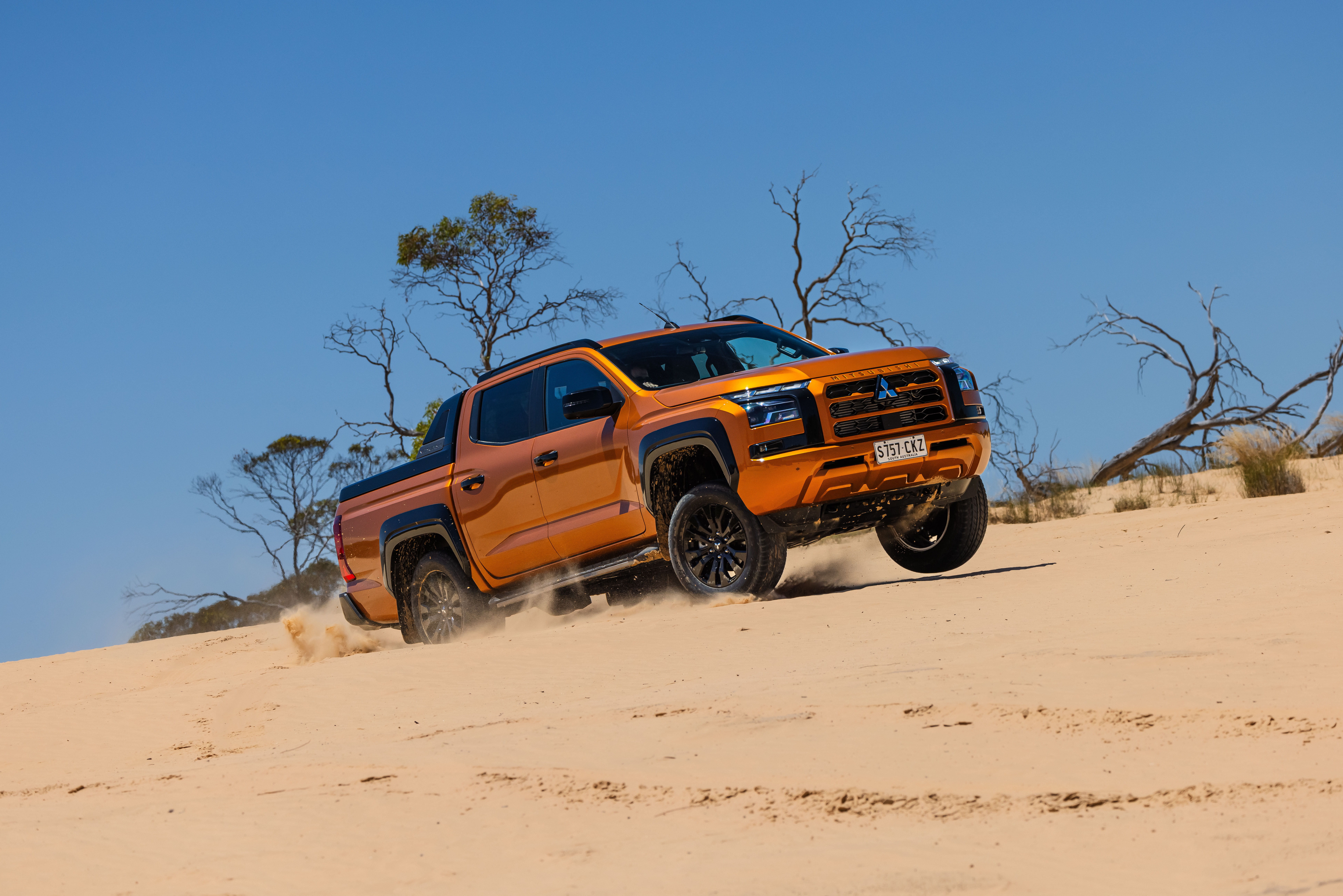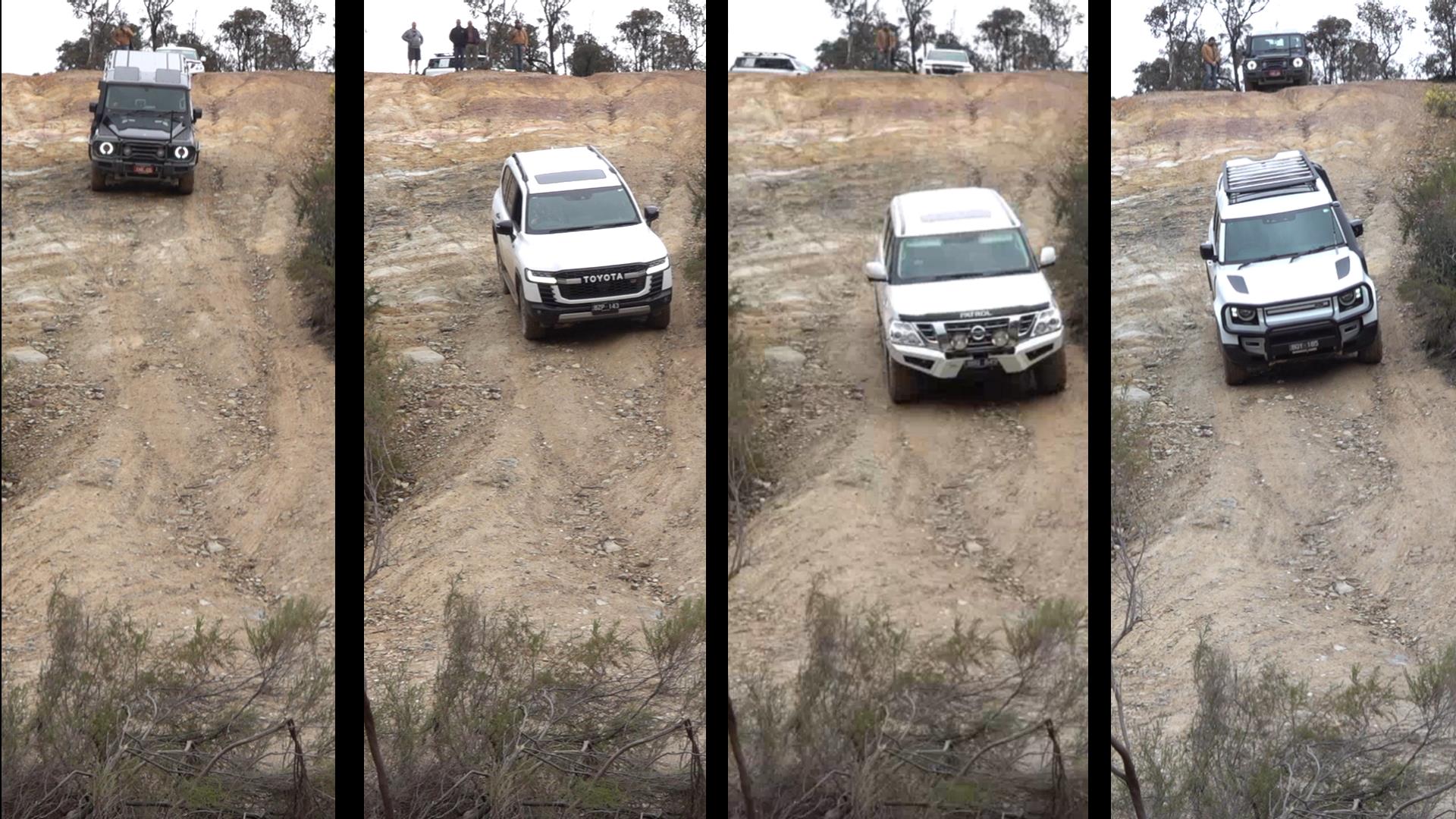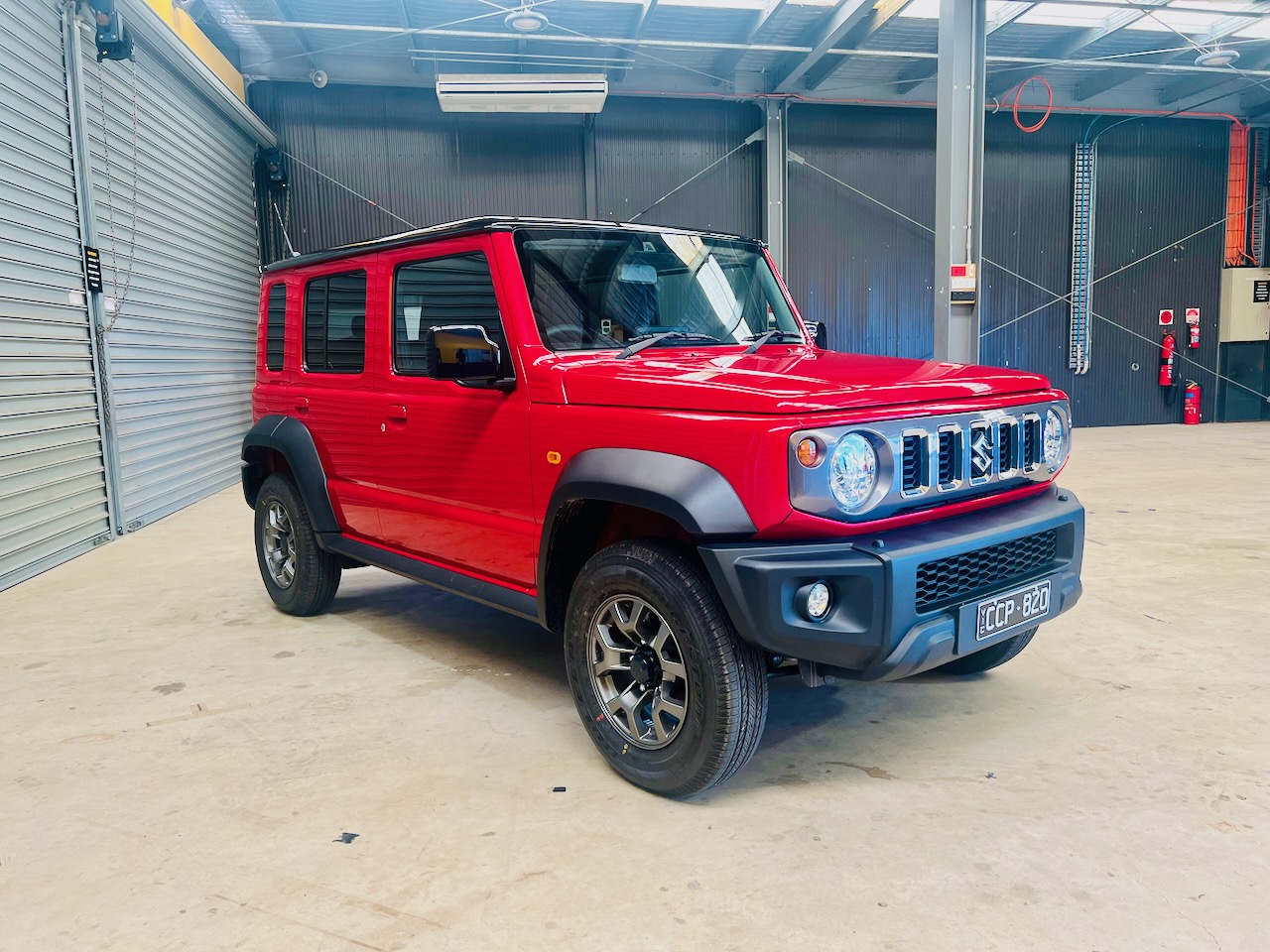Let’s not beat about the bush. A new generation Mitsubishi 2024 Triton is well and truly needed.
Yep, the fifth-generations sold in record numbers in 2022, but that was all about doing a competent job at an affordable price while lagging a fair way behind the capabilities of class leaders like the Ford Ranger, Toyota HiLux and Isuzu D-Max.

Well, Mitsubishi is talking a big, big game for the new Triton. It wants record smashing sales and it wants to poach buyers away from the likes of Ranger and HiLux in the process.
To do that Mitsubishi has developed an almost all-new Triton that addresses plenty of the old model’s shortcoming. It’s bigger, more powerful, more economic and also more expensive than its predecessor.
The new Triton goes on-sale in February, but the good news is we’ve already driven it and we can give you a sneak peek.

What I like about the 2024 Mitsubishi Triton GSR
- New frame and suspension improve comfort and stability
- Sequential turbo diesel engine improves low-end torque delivery and smoothness
- Bigger tub with better payload, the latter especially handy when towing

2024 Mitsubishi Triton problems
- The turning circle has gone up nearly one metre
- Omission of gearshift flappy paddles and parking sensor button on dash
- Still no rear disc brakes despite big hike in price

2024 Mitsubishi Triton pricing
Mitsubishi has announced a six-model launch range for the 2024 Triton and the price rises are substantial. Up at the top of the range where the big dogs fight it out, the GSR 4×4 dual cab flagship goes up $6900 to $63,840.
The GLS dual cab 4×4, which is expected to be the biggest seller, has gone up roughly $10,000 to $59,090 because there’s no longer a manual gearbox on offer.
The other models in the range are the $50,490 GLX and $53,290 GLX+ dual cab 4x4s, the $43,690 GLX dual cab 4×2 and the $50,340 GLX+ 4×4 club cab.
All come with a 2.4-litre sequential turbo diesel engine and a six-speed automatic transmissions. Single cabs, cab chassis and a manual gearbox come later.
There’s lots more gear of course, including category-first safety driver monitoring that will help achieve a five-star ANCAP result. Accessories will be a big deal too, including the first factory steel bull bar for Triton.

2024 Mitsubishi Triton changes
No half-arsed updates here. The 2024 Mitsubishi Triton is built up from an all-new ladder frame that uses more high-tensile steel and is claimed to be 60 per cent stronger in bending rigidity and 40 per cent stronger in torsional rigidity.
A new high-mount double wishbone front suspension includes larger diameter struts, while the leaf spring rear-end includes Aussie-specific tuning and larger diameter shocks. In the standard set-up used by the GLS and GSR there are now three long-span springs down from five and the heavy duty set-up in the GLX and GLX+ is down from six to four.
However, Mitsubishi has not moved its rear shocks outboard of the frame rails as Ford has done with the Ranger and Toyota with the HiLux GR Sport and Rogue. Engineers fell silent on the matter when asked why. Nor have the rear brakes swapped from drums to discs. Because the Triton sells in many developing markets, this was judged to be a cost too far.
The steering swaps from hydraulic to variable electric assist, although the turning circle goes up almost a full metre from 11.8m to 12.7m.
Key measurements apart from height also grow. The new Triton is 15mm longer overall, 50mm wider in body and tracks and a massive 130mm longer in wheelbase.
Kerb weights go up but so does payload – to more than one tonne – and the braked towing capacity climbs from 3100 to 3500kg, matching the best in segment.
Critically, the GSR and GLS have more than 600kg payload even at max towing, toppling the equivalent Ford Ranger XLT and Wildtrak four cylinders as best-in-class on this measure among premium 4×4 dual cabs.

2024 Mitsubishi Triton drivetrain
Mitsubishi calls it all-new, but the Triton’s 4N16 2.4-litre turbo-diesel engine actually appears to be a thoroughly overhauled version of the old 4N15 engine with the addition of a second turbocharger.
The combination of large low-pressure and small high-pressure turbos increases and widens the torque spread from 430Nm at 2500rpm to 470Nm at 1500-2750rpm. It’s still down on the 500Nm Hilux and Ranger four-cylinder offer though.
New pistons are one of the key contributors to an increase in power from 133kW to 150kW (both delivered at 3500rpm), bringing the Triton inline with the HiLux and within 4kW of the Ranger biturbo.
Courtesy of reduced engine friction, idle-stop and even some underbody aerodynamics, 10 per cent better fuel consumption is claimed, with that figure being 7.7L/100km.
The carryover six-speed auto is the only transmission choice for now, while the excellent Super Select II 4×4 system now has seven drive modes instead of four.
Unlike the new Ranger, the Triton does not swap to electric engine bay fans, instead sticking with viscous-couple units. Mitsubishi argues they are better for driving in heavy sands.
A perusal under the bonnet reveals a small space for a second battery has been retained. The alternator has also been raised to get it further away from potential threats.

2024 Mitsubishi Triton interior – the wide open spaces
The bluff and broad new exterior of the Triton is unrecognisable compared to its beaky predecessor and so is the interior.
The big win is more space. The bigger footprint means front-seat passengers are higher, further apart and more comfortable on new seats. The back seat has gone from one of the tightest to among the most spacious.

The nine-inch infotainment touchscreen on the dashboard is straight out of the Outlander SUV and is a vast improvement in both clarity and operation. Wireless Apple Carplay and wired Android Auto are standard. Thankfully, hard buttons are retained for some key operations.
Materials quality is lifted compared to the old Triton as well. There’s still plenty of hard points, but you no longer feel like you’ve stepped back into the 2010s.
But not all is as it should be. Mitsubishi has deleted the big manual shift flappy paddles from behind the steering wheel and there is no longer a dash-mounted switch to tun off the parking sensors – you have to drill into the menu to do that. The rear seat base still does not fold up, unlike some rivals.
The tub is a bit underwhelming too. Its long and wider and lower to aid loading, but you still can’t fit an Aussie pallet between the wheel arches. Premium touches like the Ranger’s lighting are missing.

2024 Mitsubishi Triton off-road
Peake is a small town on the Mallee Highway in the east of South Australia. On a farm not far north there’s a man-sized sand pit just right for 4×4 play.
That’s where we got to sample the new Triton. Because the GSR and GLS on offer were pre-production cars we couldn’t drive them on a public road. But Mitsubishi assured us they were fully representative of what will be in dealers.
So this review is limited to off-road, low speed and often in 4×4 high with locked centre diff and sand mode. There was no bitumen driving, no highway running and no high-speed cornering.
But there some clear improvements still emerged.

The engine delivers its increased pulling power more smoothly as well as more widely than before. The old 4N15 was a decent enough donk but this is a step forward and will help off-roading.
The frame, the wider tracks and longer wheelbase and the chassis tune makes the new Triton more comfortable and more stable, especially in the rear-end. Walking it over rock gardens produced an almost unrecognisable reduction in head toss and frame shake. Comfort levels were undoubtedly improved.
And then there’s the electric assist steering. The old hydraulic system was prone to rattle and kickback but the new set-up has ironed all that out. It’s got a quicker ratio as well, which helps with manoeuvrability and coping better with the bigger turning circle.
Add in the known capabilities of Super Select II and the sand dunes of Peake didn’t really stand a chance. The Triton ambled, scrambled or clambered to the top of anything soft, hard-packed or rock we challenged it with.

2024 Mitsubishi Triton unanswered questions
Of course, such as focussed environment meant we could not answer some questions. Have the old car’s articulation shortfall been addressed? Do the driver assist system such as traction control and ABS react less violently on rutted gravel roads? Has the tail-shaft vibration apparent in the 4×4 auto when accelerating hard under load been ironed out. Mitsubishi says yes to them all. We’ll find out soon enough.
2024 Mitsubishi Triton conclusion
If you like dual cab 4×4 utes there’s no doubt you’re living in a golden age. In recent times we’ve had the Isuzu D-Max, Ford Ranger and Volkswagen Amarok all go through generational change and improvement and had the vastly updated Toyota HiLux GR Sport and Rogue arrive.
Now it’s the Triton’s turn to be overhauled. This first drive has been too focussed to deliver definitive conclusions, but it has been enough to leave us in no doubt Mitsubishi’s decision to build the new generation up from the basics has resulted in a much better vehicle.
How good? Well, we will know more in February when Triton will be driven in a much more varied set of conditions and then gets pitched up against the best of its rivals.
But it’s pretty darn good.

2024 Mitsubishi Triton GSR specs
Engine: 2.4-litre turbo-diesel four-cylinder
Power Figures: 150kW at 3500rpm
Torque figures: 470Nm at 1500-2750rpm
Gearbox: Six-speed automatic transmission
Payload: 1085kg
Towing Capacity: 3500kg
Length: 5320mm
Width: 2865mm
Height: 1795mm
Wheelbase: 3130mm
Front Track Width: 1570mm
Rear Track Width: 1565mm










